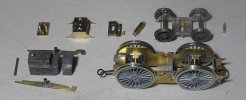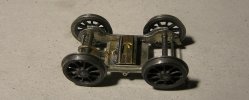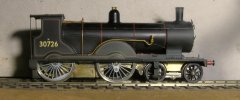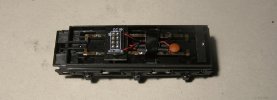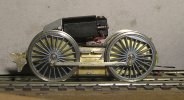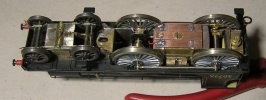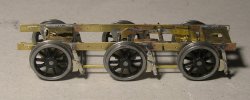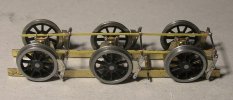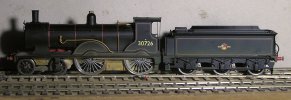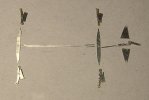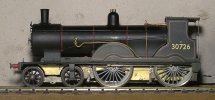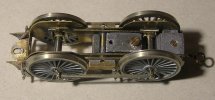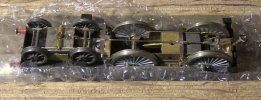Stevers
Western Thunderer
Who doesn't appreciate the looks of the lovely Hornby T9? Back in 2014 I bought 30726 with the six wheel tender thinking it would be a quick win conversion to EM using a SEF T9 etched chassis. How hard could that be? Some of you will know where this is going! The bogie was built up, and then the 'power pod'. This was offered up to the Hornby body, and it was quickly apparent that the SEF chassis was for one of those very rare birds a T9 with 9'9" wheelbase and the Hornby splashers did not in any way align with the SEF bearings. That power pod went on to be converted to 00 Gauge to go under the battered Wills T9 intended to run on Beaminster Road.
A drastic change of plan was required. Over the years I'd used a variety of Perseverance chassis, so I purchased the one originally intended for the T9 Westward kit from Chris Parrish not long after he had resumed production. The first problem was that the full length Perseverance chassis was too tall to get the correct running height where the axles should just kiss the valance. I also wanted to compensate the chassis on the twin beam principle and drive the front axle to keep the gearbox out of the beautifully appointed Hornby cab. By the time I'd finished taking enough material off the top of the chassis to attain the correct ride height and enough material underneath to articulate the bogie, it was in two parts with a power pod and a vestigial frames above the bogie. The twin beam design means that the bogie itself was the third leg and independent of the power pod.

The Persy chassis has provision for hornblock cutouts, so I fitted High Level hornblocks and filled the many voids in the chassis with lead to add weight. In a moment of madness, I came up with an excessively complicated method of side control for the bogie using a light coil spring that vastly complicates removing the bogie assembly from the body.

Attention then turned to the body, and as others have recorded there is indeed insufficient room under the splashers for EM or P4 gauge wheelsets; cue a lot of scraping and measuring to ensure that I didn't break through to the paint. Eventually enough material was removed to fit the wheels and turn it into a very successful push along toy able to navigate crossovers at very high speeds - all good so far, but without brake gear or anything else to get in the way or a gearbox to slow it down.

Somewhat disillusioned with the whine of later Escaps, I'd adopted the Multibox gearbox very early in my builds, and wanted to use one of those with a Mashima 1220 motor then readily available. It was in trying to fit the gearbox that (so to speak) the wheels fell off the project. Quite a lot of material needed to be removed from the inside of the diecast boiler and firebox and this was done with tungsten cutters in a mini drill. I was only able to remove just enough material to fit the gearbox, but not quite enough material to allow the hornblocks and compensating levers to do their thing, so that the chassis effectively rocked on the front drivers. So near and yet so far, the project was parked while I got on with other stuff - notably a full length Lima HST and then a Heljan/Penbits 33/1 + Kernow 4TC, neither remotely suited to Verwood - but huge fun to do.
Along the way the delicately detailed Hornby body suffered somewhat so will require some repairs, some of which have already been carried out. The experience I've gained with the Wills T9 build means that I will be tackling this as one of those (no doubt illusory) 'quick wins' by means of the more compact, but still excellent Road Runner gearboxes from High Level Kits. The chassis is currently in bits spread across my bench, and it would be nice to clear that mess up. As someone who is paint phobic it's unfortunate that in studying the two principal varieties of T9 for the Wills/SEF build, it's become apparent to me that the Hornby cab cutout on my narrow cab body is only correct for the wide cab version, and will need to be made deeper requiring the paintwork and lining to be revisited - doh!
A drastic change of plan was required. Over the years I'd used a variety of Perseverance chassis, so I purchased the one originally intended for the T9 Westward kit from Chris Parrish not long after he had resumed production. The first problem was that the full length Perseverance chassis was too tall to get the correct running height where the axles should just kiss the valance. I also wanted to compensate the chassis on the twin beam principle and drive the front axle to keep the gearbox out of the beautifully appointed Hornby cab. By the time I'd finished taking enough material off the top of the chassis to attain the correct ride height and enough material underneath to articulate the bogie, it was in two parts with a power pod and a vestigial frames above the bogie. The twin beam design means that the bogie itself was the third leg and independent of the power pod.

The Persy chassis has provision for hornblock cutouts, so I fitted High Level hornblocks and filled the many voids in the chassis with lead to add weight. In a moment of madness, I came up with an excessively complicated method of side control for the bogie using a light coil spring that vastly complicates removing the bogie assembly from the body.

Attention then turned to the body, and as others have recorded there is indeed insufficient room under the splashers for EM or P4 gauge wheelsets; cue a lot of scraping and measuring to ensure that I didn't break through to the paint. Eventually enough material was removed to fit the wheels and turn it into a very successful push along toy able to navigate crossovers at very high speeds - all good so far, but without brake gear or anything else to get in the way or a gearbox to slow it down.
Somewhat disillusioned with the whine of later Escaps, I'd adopted the Multibox gearbox very early in my builds, and wanted to use one of those with a Mashima 1220 motor then readily available. It was in trying to fit the gearbox that (so to speak) the wheels fell off the project. Quite a lot of material needed to be removed from the inside of the diecast boiler and firebox and this was done with tungsten cutters in a mini drill. I was only able to remove just enough material to fit the gearbox, but not quite enough material to allow the hornblocks and compensating levers to do their thing, so that the chassis effectively rocked on the front drivers. So near and yet so far, the project was parked while I got on with other stuff - notably a full length Lima HST and then a Heljan/Penbits 33/1 + Kernow 4TC, neither remotely suited to Verwood - but huge fun to do.
Along the way the delicately detailed Hornby body suffered somewhat so will require some repairs, some of which have already been carried out. The experience I've gained with the Wills T9 build means that I will be tackling this as one of those (no doubt illusory) 'quick wins' by means of the more compact, but still excellent Road Runner gearboxes from High Level Kits. The chassis is currently in bits spread across my bench, and it would be nice to clear that mess up. As someone who is paint phobic it's unfortunate that in studying the two principal varieties of T9 for the Wills/SEF build, it's become apparent to me that the Hornby cab cutout on my narrow cab body is only correct for the wide cab version, and will need to be made deeper requiring the paintwork and lining to be revisited - doh!


